操作系统原理高优先权调度算法
操作系统的调度算法优先级时间片和占式调度

操作系统的调度算法优先级时间片和占式调度操作系统的调度算法:优先级、时间片和抢占式调度操作系统是计算机系统中的一个核心组件,用于管理和控制计算机的硬件和软件资源,以提供良好的用户体验和系统性能。
在操作系统中,调度算法是实现任务分配和资源管理的关键。
本文将介绍三种常见的调度算法:优先级调度、时间片轮转调度和抢占式调度。
一、优先级调度算法优先级调度算法是根据任务的优先级安排任务的执行顺序。
每个任务都有一个优先级值,数值越高表示优先级越高。
当一个任务就绪并等待执行时,调度器会选择优先级最高的任务来执行。
优先级调度算法可以保证高优先级任务及时得到执行,但可能会导致低优先级任务出现饥饿现象。
实际上,优先级调度算法可以分为静态优先级和动态优先级两种类型。
静态优先级是在任务创建时分配的,不会改变。
动态优先级根据任务的运行情况和系统状态进行动态调整,以提高系统的公平性和性能。
二、时间片轮转调度算法时间片轮转调度算法是一种周期性调度算法,每个任务被分配一个固定的时间片(时间段),当任务的时间片用完后,调度器会将任务挂起,并将CPU 分配给下一个任务执行。
当所有任务都执行完一次后,调度器会重新分配时间片,继续按照顺序执行任务。
时间片轮转调度算法可以保证任务的平均执行时间,并且避免了长时间任务的霸占资源问题。
然而,如果任务的时间片设置得过小,则会增加任务切换的开销。
如果任务的时间片设置得过大,则可能出现对实时任务响应时间的影响。
三、抢占式调度算法抢占式调度算法是一种灵活的调度策略,允许更高优先级的任务打断正在执行的低优先级任务,以确保高优先级任务的及时响应。
当一个任务就绪并具备运行条件时,调度器会立即安排其执行,无论当前是否有其他任务在执行。
抢占式调度算法可以有效地提高系统的响应速度和实时性,但可能会导致任务切换的频繁发生,增加了系统开销。
为了平衡性能和实时性的需求,抢占式调度算法通常会和其他调度策略结合使用,例如优先级和时间片轮转。
操作系统原理高优先权调度算法

《操作系统原理》课程设计报告书题目:高优先权调度算法学号:学生姓名:专业:指导教师:5月30日目录1 功能描述 (1)2 系统设计 (1)2.1总体设计 (1)2.2详细设计 (1)2.3程序运行流程图 (1)3 系统实现 (2)3.1程序代码 (3)4 系统测试与分析 (7)4.1程序运行开始界面见图2和图3 (7)4.2高优先权程序正常运行 (8)教师评分表 (13)1 功能描述先权是指在创建进程时所赋予的优先权,是可以随进程的推进或随其等待时间的增加而改变的,以便获得更好的调度性能。
高优先权优先调度算法可以使紧迫型作业进入系统后能得到优先处理。
此算法常被用于批处理系统,作为作业调度算法,也作为多种操作系统中的进程调度算法,还可用于实时系统。
该算法用于作业调度时,系统将从后备队列中选择若干个优先权最高的作业装入内存。
当用于进程调度时,该算法是把处理机分配给就绪队列中优先权最高的进程。
2 系统设计2.1总体设计验内容利用C语言来实现对N个进程采用动态优先权优先算法的进程调度。
优先数改变的原则:进程每运行一个时间片,优先数减1。
2.2详细设计1.在运行界面里输入进程名称,进程优先级和进程时间;2.每运行一个时间单位,作业的优先权级数减一;3.在运行出的用户界面中显示初始作业名,作业状态,优先权级数,需要服务的时间,已经运行的时间;4.每次调度前后显示作业队列;2.3程序运行流程图程序运行流程图见流程图13 系统实现用c++编写的高优先权调度算法算法。
3.1程序代码程序源代码如下:#include <stdio.h>#include <stdlib.h>struct PCB{char p_name[20];int p_priority;int p_needTime;int p_runTime;char p_state;struct PCB* next;};void HighPriority();void RoundRobin();void Information();char Choice();struct PCB* SortList(PCB* HL);int main(){Information();char choice = Choice();switch(choice){case '1':system("cls");HighPriority();break;default:break;}system("pause");return 0;}void Information(){printf(" 按回车键进入演示程序");getchar();system("cls");}char Choice(){printf("\n\n");printf(" 1.演示最高优先数优先算法。
高优先权优先调度算法

FPF(head);
}
}
/*需要两个指针p和q,这两个指针均往next方向移动,
移动的过程中保持p之前的key都小于选定的key,
p和q之间的key都大于选定的key,
那么当q走到末尾的时候便完成了一次支点的寻找。*/
PCB* GetPartion(PCB *pBegin, PCB *pEnd){
int priority = pBegin->priority;
while(n--){
PCB *q=(PCB *)malloc(sizeof(PCB));q->PID=pid;q->Pname=pname;
q->state=true;// true代表未被执行
q->arrive_time=rand() % MAX_POSSIBILITY;//初始化到达时间
q->serve_time=rand() % MAX_POSSIBILITY;//随机产生进程服务时间
int t;char ch;bool f;
t=a->PID;
a->PID=b->PID;
b->PID=t;
ch=a->Pname;a->Pname=b->Pname;b->Pname=ch;
f=a->state;a->state=b->state;b->state=f;
t=a->arrive_time;a->arrive_time=b->arrive_time;b->arrive_time=t;
int sum;//头结点用于存放进程的总个数
int PID;//进程号
操作系统常用调度算法
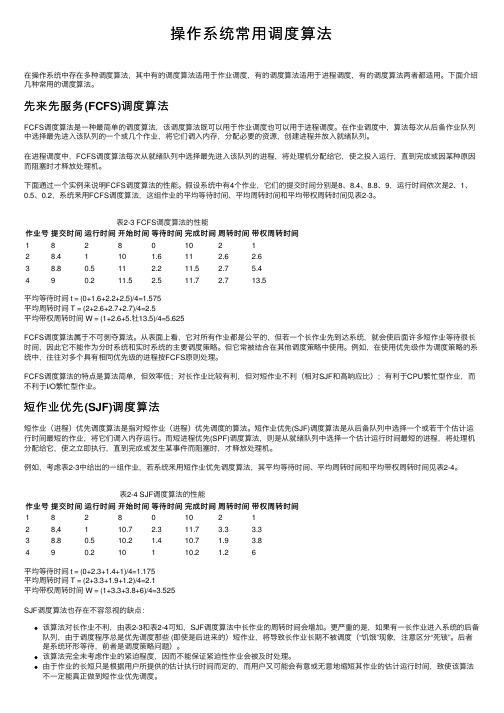
操作系统常⽤调度算法在操作系统中存在多种调度算法,其中有的调度算法适⽤于作业调度,有的调度算法适⽤于进程调度,有的调度算法两者都适⽤。
下⾯介绍⼏种常⽤的调度算法。
先来先服务(FCFS)调度算法FCFS调度算法是⼀种最简单的调度算法,该调度算法既可以⽤于作业调度也可以⽤于进程调度。
在作业调度中,算法每次从后备作业队列中选择最先进⼊该队列的⼀个或⼏个作业,将它们调⼊内存,分配必要的资源,创建进程并放⼊就绪队列。
在进程调度中,FCFS调度算法每次从就绪队列中选择最先进⼊该队列的进程,将处理机分配给它,使之投⼊运⾏,直到完成或因某种原因⽽阻塞时才释放处理机。
下⾯通过⼀个实例来说明FCFS调度算法的性能。
假设系统中有4个作业,它们的提交时间分别是8、8.4、8.8、9,运⾏时间依次是2、1、0.5、0.2,系统⾤⽤FCFS调度算法,这组作业的平均等待时间、平均周转时间和平均带权周转时间见表2-3。
表2-3 FCFS调度算法的性能作业号提交时间运⾏时间开始时间等待时间完成时间周转时间带权周转时间18280102128.4110 1.611 2.6 2.638.80.511 2.211.5 2.7 5.4490.211.5 2.511.7 2.713.5平均等待时间 t = (0+1.6+2.2+2.5)/4=1.575平均周转时间 T = (2+2.6+2.7+2.7)/4=2.5平均带权周转时间 W = (1+2.6+5.牡13.5)/4=5.625FCFS调度算法属于不可剥夺算法。
从表⾯上看,它对所有作业都是公平的,但若⼀个长作业先到达系统,就会使后⾯许多短作业等待很长时间,因此它不能作为分时系统和实时系统的主要调度策略。
但它常被结合在其他调度策略中使⽤。
例如,在使⽤优先级作为调度策略的系统中,往往对多个具有相同优先级的进程按FCFS原则处理。
FCFS调度算法的特点是算法简单,但效率低;对长作业⽐较有利,但对短作业不利(相对SJF和⾼响应⽐);有利于CPU繁忙型作业,⽽不利于I/O繁忙型作业。
高优先级调度算法

高优先级调度算法
高优先级调度算法是一种常见的进程调度算法,它的主要目的是优先
处理高优先级的进程,以保证系统的响应速度和效率。
在高优先级调
度算法中,系统会根据进程的优先级来决定进程的执行顺序,优先级
高的进程会被先执行,而优先级低的进程则会被推迟执行。
高优先级调度算法的优点在于能够保证系统的响应速度和效率,尤其
是在处理高优先级任务时,能够及时响应用户的请求,提高用户体验。
此外,高优先级调度算法还能够避免低优先级进程长时间占用CPU资源,从而保证系统的稳定性和安全性。
然而,高优先级调度算法也存在一些缺点。
首先,如果系统中存在大
量的高优先级进程,那么低优先级进程的执行可能会被推迟,从而导
致低优先级进程的响应速度变慢。
其次,如果系统中存在恶意进程或
者病毒程序,那么它们可能会通过提高自身的优先级来占用系统资源,从而影响其他进程的正常执行。
为了克服高优先级调度算法的缺点,可以采用一些优化措施。
例如,
可以设置进程的最大执行时间,避免某些进程长时间占用CPU资源。
此外,还可以采用动态优先级调度算法,根据进程的实际执行情况来
动态调整进程的优先级,从而保证系统的稳定性和安全性。
总之,高优先级调度算法是一种常见的进程调度算法,它能够保证系统的响应速度和效率,但也存在一些缺点。
为了克服这些缺点,需要采取一些优化措施,从而保证系统的稳定性和安全性。
操作系统原理高优先权调度算法

操作系统原理高优先权调度算法操作系统是计算机系统的核心软件之一,它负责管理和协调计算机硬件和软件资源,提供给用户和应用程序一个可用的、高效的运行环境。
在操作系统中,高优先权调度算法是一种重要的调度策略,它用于分配和安排任务的执行顺序,以确保高优先级的任务能够快速响应和得到及时处理。
高优先权调度算法基于任务优先级的概念,每个任务都有一个优先级值,表示其重要性和紧急程度。
较高优先级的任务被操作系统给予更高的执行优先级,以便尽快完成。
在高优先权调度算法中,任务被分为多个优先级队列,每个队列对应一个优先级。
当任务就绪并等待执行时,操作系统根据任务的优先级选择执行哪个队列中的任务。
具体的高优先权调度算法有很多种,下面介绍一些常见的算法。
1.先来先服务(FCFS)调度:按照任务到达的顺序来安排执行,不考虑任务优先级,适用于简单的环境。
但是,它没有考虑任务优先级,可能导致低优先级任务长时间等待。
2.优先级调度:根据任务的优先级来调度,优先级高的任务先被执行。
可以将任务分为多个队列,每个队列对应一个优先级,每个队列按照先进先出(FIFO)方式执行任务。
但是,优先级调度容易导致低优先级任务饥饿现象,高优先级任务可能长时间占用CPU资源。
3.最短进程优先(SJF)调度:选择估计运行时间最短的任务先执行,可以最大程度地提高系统的响应时间和吞吐量。
但是,需要准确地估计任务的运行时间,误差较大会导致系统性能下降。
4. 时间片轮转调度:将CPU的执行时间分为若干个时间片(如10ms),每个任务在一个时间片内执行,时间片用完后,任务被挂起,按照轮转的方式选择下一个任务执行。
适用于多任务环境,可以确保每个任务都能得到执行。
但是,在任务切换的过程中,会有一定的开销。
5.最短剩余时间优先(SRTF)调度:在SJF调度的基础上,动态选择剩余执行时间最短的任务进行调度,以获得更好的性能。
但是,需要频繁地更新任务的剩余执行时间,增加了系统的开销。
最高优先级别调度算法 -回复

最高优先级别调度算法-回复最高优先级调度算法,也称为抢占式调度算法,是一种操作系统调度算法,它根据进程的优先级决定下一步执行哪个进程。
本文将逐步解释最高优先级调度算法的实现、优缺点以及适用场景。
1. 算法原理:最高优先级调度算法将每个进程分配一个优先级,优先级越高的进程越有可能被调度执行。
当系统调度程序决定从运行状态切换到就绪状态时,它将首先选择具有最高优先级的进程运行。
如果当前运行的进程的优先级低于新到达就绪队列中某个进程的优先级,系统将抢占正在运行的进程,并切换到优先级更高的进程执行。
2. 实现步骤:a. 确定进程优先级:每个进程需要被赋予一个优先级值。
通常,优先级在进程创建时被分配,并且可以根据进程的重要性和紧迫性进行调整。
b. 初始化调度队列:将所有就绪进程按照优先级顺序放入就绪队列。
c. 选择最高优先级进程:当系统准备调度进程时,它将从就绪队列中选择具有最高优先级的进程。
d. 执行选中的进程:将所选的进程从就绪队列移到运行队列,并将其执行。
3. 优点:a. 响应时间快:最高优先级调度算法可以及时响应优先级最高的进程,确保重要任务快速执行。
b. 高效性:优先级高的进程更有可能被调度执行,使系统能够更高效地利用资源。
4. 缺点:a. 饥饿问题:当某个进程的优先级始终高于其他进程时,其他进程可能会长时间等待,导致饥饿问题。
b. 偏向性:如果有太多优先级较高的进程,系统可能会过度调度这些进程,导致优先级较低的进程长时间等待。
5. 适用场景:最高优先级调度算法适用于以下情况:a. 实时系统:在实时系统中,任务需要根据其重要性和紧迫性被快速执行。
b. 紧急任务:对于紧急任务,需要尽快完成,以避免可能出现的问题。
总结:最高优先级调度算法通过根据进程的优先级来决定下一个执行的进程,实现了快速响应和高效利用资源的效果。
然而,它也存在饥饿问题和偏向性的缺点。
最高优先级调度算法适用于实时和紧急任务的场景。
在实际应用中,操作系统需要根据具体系统要求和任务特点选择合适的调度算法。
高响应比优先调度算法例题详解

高响应比优先调度算法是计算机操作系统中常用的一种调度算法,它能够在多个进程同时竞争CPU资源的情况下,按照一定的规则为这些进程分配CPU时间,以实现优化系统性能的目的。
下面我们将从算法的基本原理、适用场景和实例分析等几个方面,详细解读高响应比优先调度算法。
一、算法的基本原理高响应比优先调度算法是一种非抢占式的调度算法,它根据进程的等待时间和服务时间来确定优先级,从而确定下一个执行的进程。
其基本原理可以概括为以下几点:1. 等待时间越长的进程,其优先级越高。
这是因为等待时间长的进程意味着它已经等待了很久,需要尽快得到CPU资源来执行。
2. 服务时间越短的进程,其优先级越高。
这是因为服务时间短的进程意味着它执行完成的可能性更大,因此应该优先得到CPU资源执行。
二、算法的适用场景高响应比优先调度算法适用于以下场景:1. 系统中的进程具有不同的优先级,需要根据优先级来确定下一个执行的进程。
2. 系统需要尽可能减少进程的等待时间,提高系统的响应速度。
三、例题详解接下来,我们将通过一个具体的例题来详细解读高响应比优先调度算法的应用和具体操作步骤。
假设系统中有3个进程,它们的进程控制块(PCB)信息如下:进程A:等待时间10ms,服务时间20ms进程B:等待时间5ms,服务时间15ms进程C:等待时间8ms,服务时间10ms我们将按照高响应比优先调度算法的原理来确定下一个执行的进程。
1. 计算每个进程的响应比。
响应比的计算公式为(等待时间+服务时间)/服务时间。
进程A:(10+20)/20=1.5进程B:(5+15)/15=1.33进程C:(8+10)/10=1.82. 根据计算得到的响应比来确定下一个执行的进程。
显然,进程C的响应比最高,所以应该被选为下一个执行的进程。
3. 当进程C执行完成后,再按照相同的方法来确定下一个执行的进程,直至所有进程执行完成。
通过以上例题的详解,我们可以清晰地了解高响应比优先调度算法的具体应用操作步骤和执行流程,以及在实际场景中的效果和影响。
优先级调度算法原理和短进程优先调度算法原理
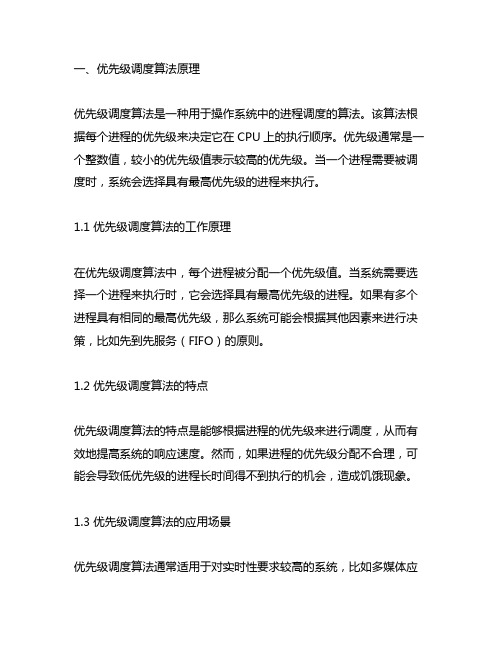
一、优先级调度算法原理优先级调度算法是一种用于操作系统中的进程调度的算法。
该算法根据每个进程的优先级来决定它在CPU上的执行顺序。
优先级通常是一个整数值,较小的优先级值表示较高的优先级。
当一个进程需要被调度时,系统会选择具有最高优先级的进程来执行。
1.1 优先级调度算法的工作原理在优先级调度算法中,每个进程被分配一个优先级值。
当系统需要选择一个进程来执行时,它会选择具有最高优先级的进程。
如果有多个进程具有相同的最高优先级,那么系统可能会根据其他因素来进行决策,比如先到先服务(FIFO)的原则。
1.2 优先级调度算法的特点优先级调度算法的特点是能够根据进程的优先级来进行调度,从而有效地提高系统的响应速度。
然而,如果进程的优先级分配不合理,可能会导致低优先级的进程长时间得不到执行的机会,造成饥饿现象。
1.3 优先级调度算法的应用场景优先级调度算法通常适用于对实时性要求较高的系统,比如多媒体应用或者交互式应用。
在这些系统中,需要优先处理一些关键的任务,以确保系统的响应速度和稳定性。
二、短进程优先调度算法原理短进程优先调度算法是一种按照进程需要的CPU时间长度进行调度的算法。
该算法先选择需要运行时间最短的进程来执行,从而能够有效地提高系统的吞吐量和响应速度。
2.1 短进程优先调度算法的工作原理在短进程优先调度算法中,系统会根据每个进程需要运行的时间长度来进行调度。
当系统需要选择一个进程来执行时,它会选择需要运行时间最短的进程。
这样可以确保每个进程都能够及时得到执行,并且能够有效地提高系统的吞吐量和响应速度。
2.2 短进程优先调度算法的特点短进程优先调度算法的特点是能够有效地提高系统的吞吐量和响应速度。
由于选择运行时间最短的进程来执行,可以确保每个进程都能够及时得到执行,从而减少了平均等待时间和平均周转时间。
2.3 短进程优先调度算法的应用场景短进程优先调度算法通常适用于需要平衡系统的吞吐量和响应速度的场景,比如多用户系统或者交互式系统。
优先级调度算法原理和短进程优先调度算法原理

优先级调度算法原理和短进程优先调度算
法原理
优先级调度算法原理:
优先级调度算法是一种根据进程优先级来确定调度顺序的调度算法。
每个进程被赋予一个优先级,优先级越高的进程越先被调度执行。
进程的优先级可以根据进程的重要性、紧急程度、资源需求等因素来确定。
优先级调度算法可以确保高优先级进程得到更多的CPU时间片,从而提高系统的响应速度和吞吐量。
优先级调度算法的原理如下:
1. 每个进程被分配一个优先级,通常用一个整数来表示,数值越小表示优先级越高。
2. 当系统中有多个就绪进程时,调度程序会选择优先级最高的进程进行执行。
3. 如果有两个或多个进程具有相同的优先级,则可以使用其他调度算法来决定哪个进程先执行,如先来先服务(FCFS)或时间片轮转法等。
短进程优先调度算法原理:
短进程优先调度算法是一种根据进程的执行时间长短来确定调度顺序的调度算法。
执行时间较短的进程会被优先调度执行,以减少平均等待时间和提高系统的响应速度。
短进程优先调度算法的原理如下:
1. 每个进程被分配一个执行时间,通常用一个整数来表示,执行时间越短表示优先级越高。
2. 当系统中有多个就绪进程时,调度程序会选择执行时间最短的进程进行执行。
3. 如果有两个或多个进程具有相同的执行时间,则可以使用其
他调度算法来决定哪个进程先执行,如先来先服务(FCFS)或时间片轮转法等。
短进程优先调度算法的优点是能够最大程度地减少平均等待时间,提高系统的响应速度。
然而,该算法可能会导致长时间执行的进程等待时间过长,产生饥饿现象。
因此,在实际应用中,需要根据具体情况选择合适的调度算法来平衡各种因素。
操作系统原理高优先权调度算法
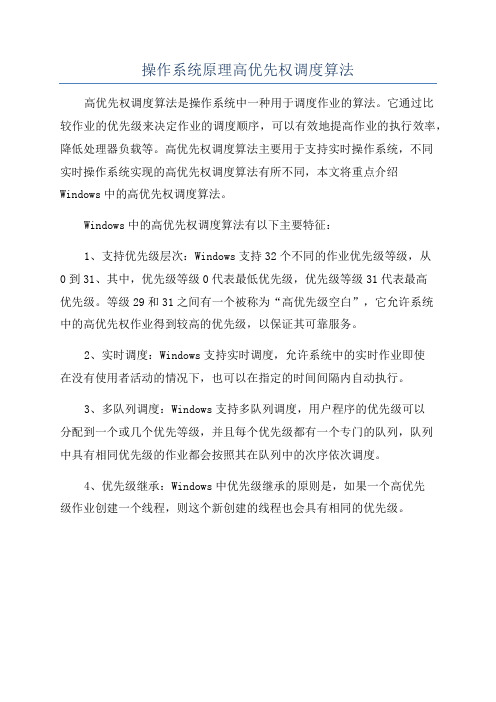
操作系统原理高优先权调度算法
高优先权调度算法是操作系统中一种用于调度作业的算法。
它通过比
较作业的优先级来决定作业的调度顺序,可以有效地提高作业的执行效率,降低处理器负载等。
高优先权调度算法主要用于支持实时操作系统,不同
实时操作系统实现的高优先权调度算法有所不同,本文将重点介绍Windows中的高优先权调度算法。
Windows中的高优先权调度算法有以下主要特征:
1、支持优先级层次:Windows支持32个不同的作业优先级等级,从
0到31、其中,优先级等级0代表最低优先级,优先级等级31代表最高
优先级。
等级29和31之间有一个被称为“高优先级空白”,它允许系统
中的高优先权作业得到较高的优先级,以保证其可靠服务。
2、实时调度:Windows支持实时调度,允许系统中的实时作业即使
在没有使用者活动的情况下,也可以在指定的时间间隔内自动执行。
3、多队列调度:Windows支持多队列调度,用户程序的优先级可以
分配到一个或几个优先等级,并且每个优先级都有一个专门的队列,队列
中具有相同优先级的作业都会按照其在队列中的次序依次调度。
4、优先级继承:Windows中优先级继承的原则是,如果一个高优先
级作业创建一个线程,则这个新创建的线程也会具有相同的优先级。
操作系统四种调度算法

操作系统四种调度算法操作系统对进程的调度一般上有四种常见的算法。
下面由店铺为大家整理了操作系统的四种调度算法的相关知识,希望对大家有帮助!操作系统四重调度算法之一、先来先服务调度算法先来先服务(FCFS)调度算法是一种最简单的调度算法,该算法既可用于作业调度,也可用于进程调度。
当在作业调度中采用该算法时,每次调度都是从后备作业队列中选择一个或多个最先进入该队列的作业,将它们调入内存,为它们分配资源、创建进程,然后放入就绪队列。
在进程调度中采用FCFS算法时,则每次调度是从就绪队列中选择一个最先进入该队列的进程,为之分配处理机,使之投入运行。
该进程一直运行到完成或发生某事件而阻塞后才放弃处理机。
操作系统四重调度算法之二、短作业(进程)优先调度算法短作业(进程)优先调度算法SJ(P)F,是指对短作业或短进程优先调度的算法。
它们可以分别用于作业调度和进程调度。
短作业优先(SJF)的调度算法是从后备队列中选择一个或若干个估计运行时间最短的作业,将它们调入内存运行。
而短进程优先(SPF)调度算法则是从就绪队列中选出一个估计运行时间最短的进程,将处理机分配给它,使它立即执行并一直执行到完成,或发生某事件而被阻塞放弃处理机时再重新调度。
操作系统四重调度算法之三、高优先权优先调度算法1.优先权调度算法的类型为了照顾紧迫型作业,使之在进入系统后便获得优先处理,引入了最高优先权优先(FPF)调度算法。
此算法常被用于批处理系统中,作为作业调度算法,也作为多种操作系统中的进程调度算法,还可用于实时系统中。
当把该算法用于作业调度时,系统将从后备队列中选择若干个优先权最高的作业装入内存。
当用于进程调度时,该算法是把处理机分配给就绪队列中优先权最高的进程,这时,又可进一步把该算法分成如下两种。
1) 非抢占式优先权算法在这种方式下,系统一旦把处理机分配给就绪队列中优先权最高的进程后,该进程便一直执行下去,直至完成;或因发生某事件使该进程放弃处理机时,系统方可再将处理机重新分配给另一优先权最高的进程。
计算机操作系统调度算法
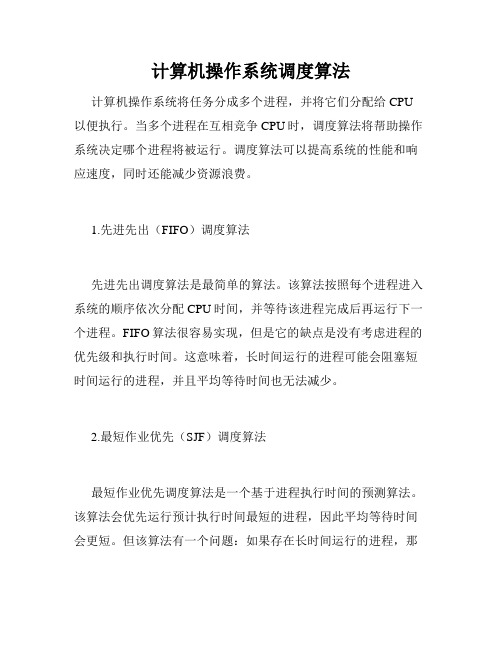
计算机操作系统调度算法计算机操作系统将任务分成多个进程,并将它们分配给CPU 以便执行。
当多个进程在互相竞争CPU时,调度算法将帮助操作系统决定哪个进程将被运行。
调度算法可以提高系统的性能和响应速度,同时还能减少资源浪费。
1.先进先出(FIFO)调度算法先进先出调度算法是最简单的算法。
该算法按照每个进程进入系统的顺序依次分配CPU时间,并等待该进程完成后再运行下一个进程。
FIFO算法很容易实现,但是它的缺点是没有考虑进程的优先级和执行时间。
这意味着,长时间运行的进程可能会阻塞短时间运行的进程,并且平均等待时间也无法减少。
2.最短作业优先(SJF)调度算法最短作业优先调度算法是一个基于进程执行时间的预测算法。
该算法会优先运行预计执行时间最短的进程,因此平均等待时间会更短。
但该算法有一个问题:如果存在长时间运行的进程,那么它们可能永远无法运行,这会导致一些进程一直处于等待状态。
3.优先级调度算法优先级调度算法通过为每个进程分配不同的优先级,来确定哪个进程应该先运行。
预设的进程优先级可能基于进程的类型、缺陷、执行时间和操作系统要求等因素。
4.时间片轮转(RR)调度算法时间片轮转调度算法是一种基于时间分配CPU时间的算法。
该算法为每个进程分配一个小的时间片,如10ms或50ms,并按照时间片依次运行进程。
如果进程无法在一个时间片内完成,则进程被送到队列的末尾。
时间片轮转调度算法可以避免长时间运行的进程阻塞短时间运行的进程,并提高平均等待时间。
5.多级反馈队列(MFQ)调度算法多级反馈队列调度算法是一种结合了以上几种调度算法的算法。
它将进程分配到几个队列中,每个队列有不同的优先级和时间片。
优先级高,时间片较长的队列中,会先运行高优先级的进程。
如果进程超出了它被分配的时间,并在该队列中一直等待,进程会在等待时间超过设定时间限制后继续移动到更低优先级的队列。
总结不同的任务需要不同的调度算法。
例如,对于短时间运行的进程,SJF算法可能表现最好,而RR算法适用于需要等待时间短的任务。
实验3高优先权优先的进程调度算法模拟
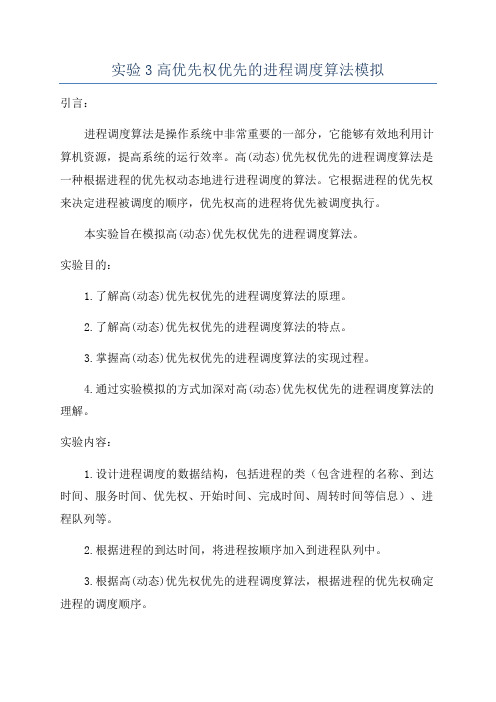
实验3高优先权优先的进程调度算法模拟引言:进程调度算法是操作系统中非常重要的一部分,它能够有效地利用计算机资源,提高系统的运行效率。
高(动态)优先权优先的进程调度算法是一种根据进程的优先权动态地进行进程调度的算法。
它根据进程的优先权来决定进程被调度的顺序,优先权高的进程将优先被调度执行。
本实验旨在模拟高(动态)优先权优先的进程调度算法。
实验目的:1.了解高(动态)优先权优先的进程调度算法的原理。
2.了解高(动态)优先权优先的进程调度算法的特点。
3.掌握高(动态)优先权优先的进程调度算法的实现过程。
4.通过实验模拟的方式加深对高(动态)优先权优先的进程调度算法的理解。
实验内容:1.设计进程调度的数据结构,包括进程的类(包含进程的名称、到达时间、服务时间、优先权、开始时间、完成时间、周转时间等信息)、进程队列等。
2.根据进程的到达时间,将进程按顺序加入到进程队列中。
3.根据高(动态)优先权优先的进程调度算法,根据进程的优先权确定进程的调度顺序。
4.模拟进程调度的过程,计算进程的开始时间、完成时间、周转时间等信息。
5.最终输出每个进程的调度结果。
实验步骤:第一步:设计进程调度的数据结构首先,我们需要设计进程调度的数据结构,包括进程的类和进程队列。
进程的类包含进程的名称、到达时间、服务时间、优先权、开始时间、完成时间、周转时间等信息。
进程队列用于存储待调度的进程。
第二步:加入进程到进程队列中在模拟进程调度的过程中,我们需要按照进程的到达时间将进程按顺序加入到进程队列中。
根据实际需求,可以手动输入进程的信息或者随机生成进程的信息。
第三步:根据优先权确定进程的调度顺序在高(动态)优先权优先的进程调度算法中,进程的调度顺序是根据进程的优先权确定的。
优先权高的进程将优先被调度执行。
因此,我们需要根据进程的优先权对进程队列进行排序。
第四步:模拟进程调度的过程在实验中,我们需要模拟进程调度的过程。
根据调度算法,选择优先权最高的进程进行调度。
高优先权优先的进程调度算法模拟
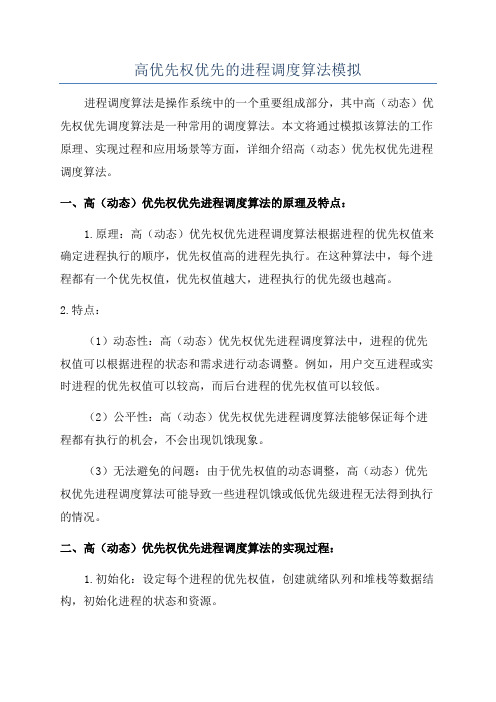
高优先权优先的进程调度算法模拟进程调度算法是操作系统中的一个重要组成部分,其中高(动态)优先权优先调度算法是一种常用的调度算法。
本文将通过模拟该算法的工作原理、实现过程和应用场景等方面,详细介绍高(动态)优先权优先进程调度算法。
一、高(动态)优先权优先进程调度算法的原理及特点:1.原理:高(动态)优先权优先进程调度算法根据进程的优先权值来确定进程执行的顺序,优先权值高的进程先执行。
在这种算法中,每个进程都有一个优先权值,优先权值越大,进程执行的优先级也越高。
2.特点:(1)动态性:高(动态)优先权优先进程调度算法中,进程的优先权值可以根据进程的状态和需求进行动态调整。
例如,用户交互进程或实时进程的优先权值可以较高,而后台进程的优先权值可以较低。
(2)公平性:高(动态)优先权优先进程调度算法能够保证每个进程都有执行的机会,不会出现饥饿现象。
(3)无法避免的问题:由于优先权值的动态调整,高(动态)优先权优先进程调度算法可能导致一些进程饥饿或低优先级进程无法得到执行的情况。
二、高(动态)优先权优先进程调度算法的实现过程:1.初始化:设定每个进程的优先权值,创建就绪队列和堆栈等数据结构,初始化进程的状态和资源。
2. 进程调度:根据进程的优先权值,从就绪队列中选择优先权值最高的进程进行执行。
如果存在多个优先权值相同的进程,可以使用先到先服务(FIFO)或轮转(Round-robin)等调度策略来决定执行顺序。
3.执行进程:将选中的进程从就绪队列中移除,并切换到该进程的上下文,开始执行进程的指令。
4.中断处理或进程阻塞:在进程执行过程中,如果发生中断事件(如I/O请求、信号响应等),则暂停当前进程的执行,并将其状态置为阻塞态,将进程放入阻塞队列中等待事件完成或唤醒信号。
5.进程唤醒或时间片过期:当进程阻塞的事件完成或等待一段时间后,重新将该进程放入就绪队列中,更新其优先权值。
6.进程终止或等待:当进程执行完所有指令或主动请求等待时,将进程从系统中移除,并释放其占用的资源。
最高优先数优先算法
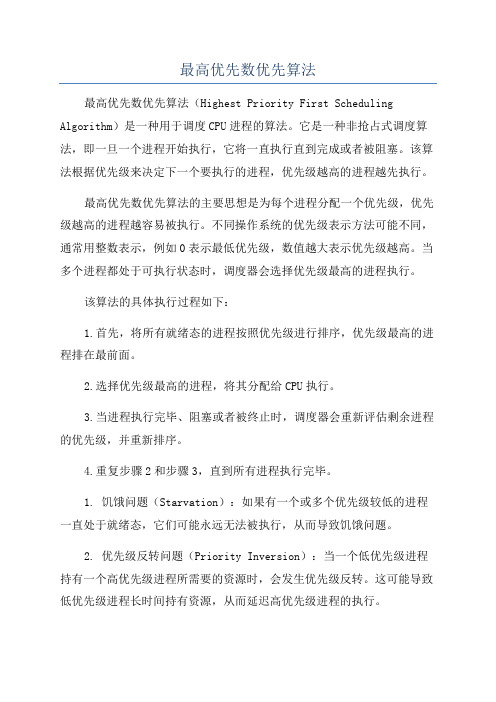
最高优先数优先算法最高优先数优先算法(Highest Priority First Scheduling Algorithm)是一种用于调度CPU进程的算法。
它是一种非抢占式调度算法,即一旦一个进程开始执行,它将一直执行直到完成或者被阻塞。
该算法根据优先级来决定下一个要执行的进程,优先级越高的进程越先执行。
最高优先数优先算法的主要思想是为每个进程分配一个优先级,优先级越高的进程越容易被执行。
不同操作系统的优先级表示方法可能不同,通常用整数表示,例如0表示最低优先级,数值越大表示优先级越高。
当多个进程都处于可执行状态时,调度器会选择优先级最高的进程执行。
该算法的具体执行过程如下:1.首先,将所有就绪态的进程按照优先级进行排序,优先级最高的进程排在最前面。
2.选择优先级最高的进程,将其分配给CPU执行。
3.当进程执行完毕、阻塞或者被终止时,调度器会重新评估剩余进程的优先级,并重新排序。
4.重复步骤2和步骤3,直到所有进程执行完毕。
1. 饥饿问题(Starvation):如果有一个或多个优先级较低的进程一直处于就绪态,它们可能永远无法被执行,从而导致饥饿问题。
2. 优先级反转问题(Priority Inversion):当一个低优先级进程持有一个高优先级进程所需要的资源时,会发生优先级反转。
这可能导致低优先级进程长时间持有资源,从而延迟高优先级进程的执行。
3.不公平问题:由于该算法始终选择优先级最高的进程执行,优先级较低的进程可能无法得到公平的执行机会。
为了解决上述问题,可以引入以下改进措施:1.动态优先级调整:在进程等待CPU时间越长,其优先级会随之提高,以避免饥饿问题。
2.基于优先级的资源分配:为了防止优先级反转,可以根据请求资源的优先级来分配资源。
3.时间片轮转:结合时间片轮转算法和最高优先数优先算法,以平衡对高优先级进程和低优先级进程的响应。
总之,最高优先数优先算法是一种简单且易于实现的调度算法,对于有紧急任务和对响应时间要求高的环境是合适的。
最高优先数优先”调度算法
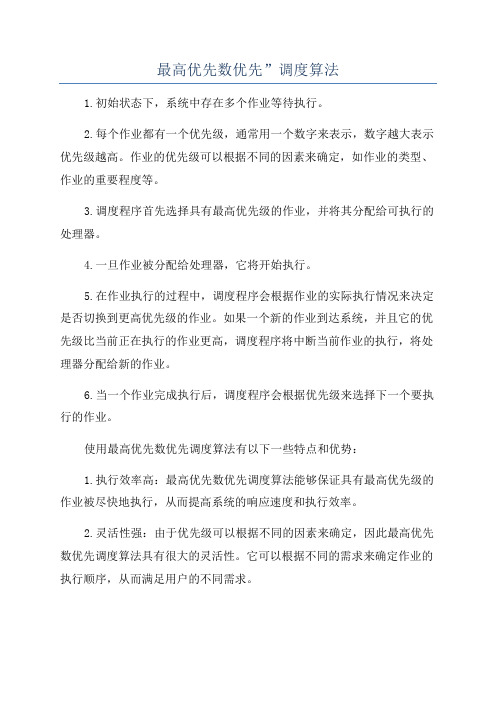
最高优先数优先”调度算法1.初始状态下,系统中存在多个作业等待执行。
2.每个作业都有一个优先级,通常用一个数字来表示,数字越大表示优先级越高。
作业的优先级可以根据不同的因素来确定,如作业的类型、作业的重要程度等。
3.调度程序首先选择具有最高优先级的作业,并将其分配给可执行的处理器。
4.一旦作业被分配给处理器,它将开始执行。
5.在作业执行的过程中,调度程序会根据作业的实际执行情况来决定是否切换到更高优先级的作业。
如果一个新的作业到达系统,并且它的优先级比当前正在执行的作业更高,调度程序将中断当前作业的执行,将处理器分配给新的作业。
6.当一个作业完成执行后,调度程序会根据优先级来选择下一个要执行的作业。
使用最高优先数优先调度算法有以下一些特点和优势:1.执行效率高:最高优先数优先调度算法能够保证具有最高优先级的作业被尽快地执行,从而提高系统的响应速度和执行效率。
2.灵活性强:由于优先级可以根据不同的因素来确定,因此最高优先数优先调度算法具有很大的灵活性。
它可以根据不同的需求来确定作业的执行顺序,从而满足用户的不同需求。
3.适应性好:最高优先数优先调度算法能够适应不同的系统负载和作业类型。
它可以根据系统中的实际情况来动态地调整作业的优先级,从而提高系统的整体性能。
然而,最高优先数优先调度算法也存在一些不足之处:1.可能导致饥饿问题:由于最高优先数优先调度算法总是优先选择优先级最高的作业执行,因此优先级较低的作业可能会长时间地等待,甚至会发生饥饿现象。
2.优先级的确定可能存在问题:确定作业的优先级是非常关键的,如果优先级的设置不合理,可能会导致系统的负载不均衡,一些重要的作业无法及时得到执行。
总的来说,最高优先数优先调度算法是一种简单而高效的作业调度算法。
它可以根据作业的优先级来动态地分配处理器资源,从而提高系统的响应速度和执行效率。
然而,在实际应用中,我们需要根据系统的具体情况来选择合适的调度算法,以满足系统的实际需求。
操作系统 低中高级调度
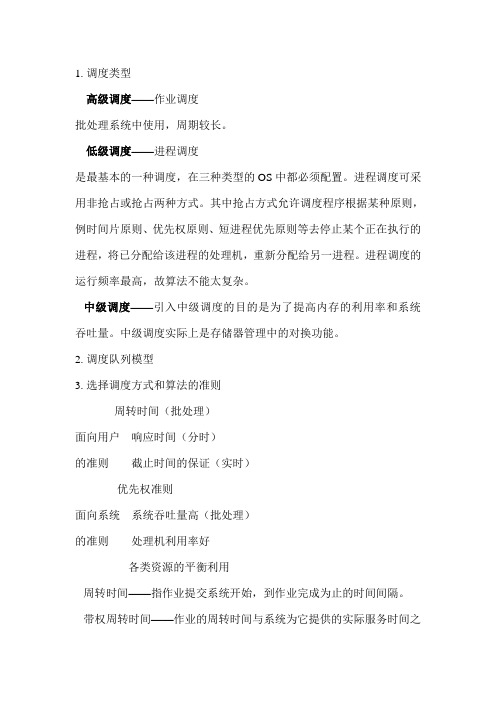
1. 调度类型高级调度——作业调度批处理系统中使用,周期较长。
低级调度——进程调度是最基本的一种调度,在三种类型的OS中都必须配置。
进程调度可采用非抢占或抢占两种方式。
其中抢占方式允许调度程序根据某种原则,例时间片原则、优先权原则、短进程优先原则等去停止某个正在执行的进程,将已分配给该进程的处理机,重新分配给另一进程。
进程调度的运行频率最高,故算法不能太复杂。
中级调度——引入中级调度的目的是为了提高内存的利用率和系统吞吐量。
中级调度实际上是存储器管理中的对换功能。
2. 调度队列模型3. 选择调度方式和算法的准则周转时间(批处理)面向用户响应时间(分时)的准则截止时间的保证(实时)优先权准则面向系统系统吞吐量高(批处理)的准则处理机利用率好各类资源的平衡利用周转时间——指作业提交系统开始,到作业完成为止的时间间隔。
带权周转时间——作业的周转时间与系统为它提供的实际服务时间之比。
W=T/TS响应时间——从用户通过键盘提交一个请求开始,直至系统首次产生响应为止的时间。
截止时间——某任务必须开始执行的最迟时间,或必须完成的最迟时间。
吞吐量——单位时间内所完成的作业数。
4. 调度算法(作业调度、进程调度)先来先服务调度算法(FCFS)按进入后备(或就绪)队列的先后选择目标作业(或进程)。
有利于长作业(进程),不利于短作业(进程)。
最短作业优先调度算法SJ(P)F从后备(或就绪)队列中选择估计运行时间最短的作业(或进程)tn+1=a tn+(1-a) tn tn为实际值,tn为预测值SJF有效地降低作业的平均等待时间,提高了系统的吞吐量。
对长作业(或进程)不利,可能死等,且未考虑作业的紧迫程度。
时间片轮转调度算法(进程调度)系统将所有的就绪进程按先来先服务原则,排成一个队列,每次调度时把CPU分配给队首进程,令其执行一个时间片。
就绪队列中所有进程,在一个给定的时间内,均能获得一个时间片的处理机执行时间。
T=nq优先权调度算法适用于作业调度和进程调度。
优先级调度算法doc

优先级调度算法.doc 优先级调度算法是一种常见的任务调度方法,广泛应用于操作系统和多任务处理领域。
它根据任务的优先级来决定任务的执行顺序,优先级高的任务先于优先级低的任务执行。
这种算法可以保证重要任务及时得到处理,提高系统的响应速度和效率。
一、优先级调度算法的原理优先级调度算法的基本原理是将系统中的任务按照优先级分为多个队列,每个队列中的任务按照优先级从高到低的顺序排列。
当系统空闲时,从最高优先级队列中选择一个任务执行,如果该任务需要等待,则等待直到其到达执行时间。
当有多个任务同时处于就绪状态时,系统会选择优先级最高的任务执行。
二、优先级调度算法的分类根据任务优先级的确定方式不同,优先级调度算法可以分为静态优先级调度算法和动态优先级调度算法。
1.静态优先级调度算法静态优先级调度算法是指在任务调度前,预先确定每个任务的优先级,然后按照优先级顺序执行任务。
这种算法的优点是简单易行,适用于任务数量较少且固定的情况。
但是,如果任务的优先级发生变化或者有新的任务加入,需要重新安排任务的执行顺序,这会增加系统的开销。
2.动态优先级调度算法动态优先级调度算法是指根据任务的执行情况和系统资源的使用情况动态地调整任务的优先级。
这种算法的优点是能够适应系统环境的变化,提高系统的效率和响应速度。
但是,动态优先级调度算法的实现较为复杂,需要系统提供实时的任务调度和资源分配支持。
三、优先级调度算法的应用优先级调度算法广泛应用于操作系统、多任务处理、实时系统等领域。
例如,Unix/Linux操作系统中的进程调度就是基于优先级调度算法实现的。
在工业控制领域,实时操作系统的任务调度也是基于优先级调度算法实现的。
此外,在云计算、大数据等领域,优先级调度算法也得到了广泛应用。
四、优先级调度算法的优缺点1.优点:(1) 可以根据任务的紧急程度和重要性来确定任务的优先级,从而保证重要任务及时得到处理。
(2) 可以根据任务的执行情况和系统资源的使用情况动态地调整任务的优先级,提高系统的效率和响应速度。
- 1、下载文档前请自行甄别文档内容的完整性,平台不提供额外的编辑、内容补充、找答案等附加服务。
- 2、"仅部分预览"的文档,不可在线预览部分如存在完整性等问题,可反馈申请退款(可完整预览的文档不适用该条件!)。
- 3、如文档侵犯您的权益,请联系客服反馈,我们会尽快为您处理(人工客服工作时间:9:00-18:30)。
《操作系统原理》课程设计报告书题目:高优先权调度算法学号:学生姓名:专业:指导教师:5月30日目录1 功能描述 (1)2 系统设计 (1)2.1总体设计 (1)2.2详细设计 (1)2.3程序运行流程图 (1)3 系统实现 (2)3.1程序代码 (3)4 系统测试与分析 (7)4.1程序运行开始界面见图2和图3 (7)4.2高优先权程序正常运行 (8)教师评分表 (13)1 功能描述先权是指在创建进程时所赋予的优先权,是可以随进程的推进或随其等待时间的增加而改变的,以便获得更好的调度性能。
高优先权优先调度算法可以使紧迫型作业进入系统后能得到优先处理。
此算法常被用于批处理系统,作为作业调度算法,也作为多种操作系统中的进程调度算法,还可用于实时系统。
该算法用于作业调度时,系统将从后备队列中选择若干个优先权最高的作业装入内存。
当用于进程调度时,该算法是把处理机分配给就绪队列中优先权最高的进程。
2 系统设计2.1总体设计验内容利用C语言来实现对N个进程采用动态优先权优先算法的进程调度。
优先数改变的原则:进程每运行一个时间片,优先数减1。
2.2详细设计1.在运行界面里输入进程名称,进程优先级和进程时间;2.每运行一个时间单位,作业的优先权级数减一;3.在运行出的用户界面中显示初始作业名,作业状态,优先权级数,需要服务的时间,已经运行的时间;4.每次调度前后显示作业队列;2.3程序运行流程图程序运行流程图见流程图13 系统实现用c++编写的高优先权调度算法算法。
3.1程序代码程序源代码如下:#include <stdio.h>#include <stdlib.h>struct PCB{char p_name[20];int p_priority;int p_needTime;int p_runTime;char p_state;struct PCB* next;};void HighPriority();void RoundRobin();void Information();char Choice();struct PCB* SortList(PCB* HL);int main(){Information();char choice = Choice();switch(choice){case '1':system("cls");HighPriority();break;default:break;}system("pause");return 0;}void Information(){printf(" 按回车键进入演示程序");getchar();system("cls");}char Choice(){printf("\n\n");printf(" 1.演示最高优先数优先算法。
");printf(" 按1继续:");char ch = getchar();return ch;system("cls");}void HighPriority(){struct PCB *processes, *pt;//pt作为临时节点来创建链表,使用for语句,限制进程数为5个processes = pt = (struct PCB*)malloc(sizeof(struct PCB));for (int i = 0; i != 5; ++i){struct PCB *p = (struct PCB*)malloc(sizeof(struct PCB));printf("进程号No.%d:\n", i);printf("输入进程名:");scanf("%s", p->p_name);printf("输入进程优先数:");scanf("%d", &p->p_priority);printf("输入进程运行时间:");scanf("%d", &p->p_needTime);p->p_runTime = 0;p->p_state = 'W';p->next = NULL;pt->next = p;pt = p;printf("\n\n");}getchar(); //接受回车//processes作为头结点来存储链表processes = processes->next;int cases = 0;struct PCB *psorted = processes;while (1){pt = processes;//对链表按照优先数排序//psorted用来存放排序后的链表psorted = SortList(psorted);printf("The execute number: %d\n\n", cases);printf("**** 当前正在运行的进程是:%s\n", psorted->p_name);psorted->p_state = 'R';printf("qname state super ndtime runtime\n");printf("%s\t%c\t%d\t%d\t%d\t\n\n", psorted->p_name, psorted->p_state, psorted->p_priority, psorted->p_needTime, psorted->p_runTime);pt->p_state = 'W';psorted->p_runTime++;psorted->p_priority--;printf("**** 当前就绪状态的队列为:\n\n");//pt指向已经排序的队列pt = psorted->next;while (pt != NULL){printf("qname state super ndtime runtime\n");printf("%s\t%c\t%d\t%d\t%d\t\n\n", pt->p_name, pt->p_state, pt->p_priority, pt->p_needTime, pt->p_runTime);pt = pt->next;}//pt指向已经排序的链表,判断链表是否有已用时间啊等于需要时间的pt = psorted;struct PCB *ap;ap = NULL; //ap指向pt的前一个节点while (pt != NULL){if (pt->p_needTime == pt->p_runTime){if (ap == NULL){pt = psorted->next;psorted = pt;}elseap->next = pt->next;}ap = pt;pt = pt->next;}if (psorted->next == NULL)getchar();}}struct PCB* SortList(PCB* HL){struct PCB* SL;SL = (struct PCB*)malloc(sizeof(struct PCB));SL = NULL;struct PCB* r = HL;while (r != NULL){struct PCB* t = r->next;struct PCB* cp = SL;struct PCB* ap = NULL;while (cp != NULL){if (r->p_priority > cp->p_priority)break;else{ap = cp;cp = cp->next;}}if (ap == NULL){r->next = SL;SL = r;}else{r->next = cp;ap->next = r;}r = t;}return SL;}4 系统测试与分析经过测试运行正常,可以达到预期的输出结果。
4.1程序运行开始界面见图2和图3图2图34.2高优先权程序正常运行输入进程名输入5个进程名、优先数、运行时间,然后程序自动从就绪队列中选择优先级高的进程运行优先执行,一直到所有进程全部运行完毕。
具体的见图4—图12。
图4图5 图6图7 图8图9 图10图11 图12教师评分表。
